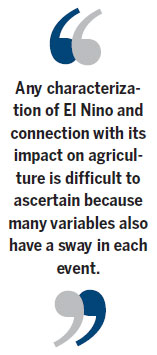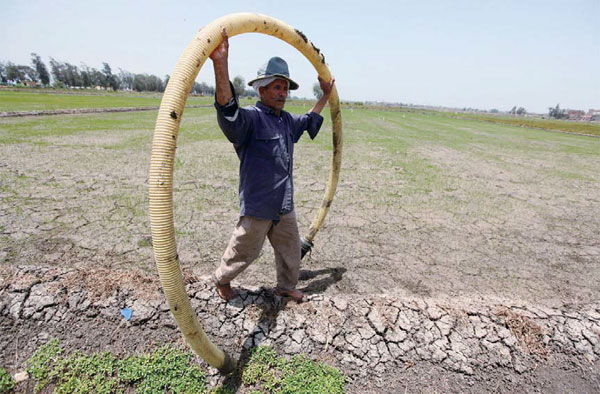Devil is in detail when El Nino strikes
|
An Egyptian farmer in El-Dakahlya pumps water from a well to irrigate his field, which has been affected by drought. The field was earlier irrigated by the River Nile. Mohamed Abd El Ghany / Reuters |
Climate phenomena are tricky, and close study is essential to determine what they might mean for food security, floods and droughts
El Nino is a warming of surface waters that takes place in the equatorial zone of the central and eastern Pacific Ocean, affecting atmospheric circulation worldwide. It usually peaks around Christmas, hence the name of the phenomenon: El Nino is Spanish for Christ Child.
La Nina refers to the cold equivalent of El Nino. It is a recurrent weather phenomenon that takes place every two to seven years and usually lasts between 12 and 18 months.

The Food and Agriculture Organization of the United Nations does not have a mandate in the geophysical aspects of the El Nino phenomenon, yet the organization's interests focus on the impacts on agriculture and, consequently, food security of the extreme negative and positive climatic events that can be triggered by El Nino.
The impact on agriculture of an El Nino occurrence could be mitigated by a La Nina's dominance cycle, and, vice versa, La Nina's impact on agriculture could be exacerbated by El Nino dominance, according to a study by the FAO.
This fact could explain the weak correlation found between the intensity of an El Nino event and drought conditions at global level. For instance, El Nino 1997-98, called "the climate event of the century", did not have a major effect on the agricultural areas of the world. The reasons are not completely clear.
El Nino 1997-98 started at the same time as El Nino 1991-92, in April, May and June, with a similar duration (only two months shorter) at almost twice the intensity, but had very little influence on agriculture: El Nino 1991-92 caused drought in approximately 350 million hectares, while El Nino 1997-98 affected 80 million hectares (77 percent less). Additional information is necessary to capture the complexity of the interaction between agricultural production, climate and oceanic temperatures and currents.
Any characterization of El Nino and connection with its impact on agriculture is difficult to ascertain because many variables also have a sway in each event, including the gestation period, which may start from a neutral, positive (La Nina) or negative (El Nino) phase, and in the onset time, intensity and duration of an El Nino occurrence.
All these variables, in turn, interact with other dynamic variables of vegetation development. For instance, El Nino's effect on crop conditions and development depends on the timing and sensitivity of crops during the peak period of influence of the event, because the flowering and grain filling phases of cereal crops are more sensitive to moisture deficits. It is also important to consider the variation in technology used in different agricultural areas. The real numbers of variables are unknown, making the situation more complex, while atmosphere, ocean and crop dynamics interact at different moments.
Annual crops planted in October and November in the southern hemisphere have a low probability of being affected during an El Nino event, because planting occurs in the previous year and harvesting takes place in March and April, normally before the declaration of El Nino.
During the past 30 years, early onsets of El Nino events have occurred in April, May and June, with the exception of El Nino 1953-54, a unique case in 64 years of recording these events. On the other hand, these areas have a high probability of being affected during the second year of El Nino. The intensity of the negative impact has demonstrated to be linked to the duration of the event.
Annual crops planted in April and May in the southern hemisphere and harvested in August and September have a higher probability of being affected by El Nino in the same year of gestation and onset of the event. For instance, in Australia, crops were affected by drought from the beginning to the end of the 2006 crop season. However, in 2007 (the second year of El Nino 2006-07), crops were affected mainly during the first half of the crop season as conditions improved at the end of the cycle when the effects of El Nino diminished.
In the northern hemisphere, annual crops planted in May in the Americas during some El Nino years show the first signals of drought during the development of El Nino.
For instance, the dry corridor of Central America, the Caribbean, Colombia and Venezuela are very likely to suffer from drought if El Nino gestation develops early in the year (before May). In Central America, El Nino could intensify the effect of the phenomenon known as Canicula or Veranillo de San Juan, a reduction of the rainfall during July and August affecting the first crop season and the planting period of the second one.
The United States and Canada, where crops are planted in March and April, can be affected during the first year of El Nino because flowering and grain filling occur around August. In the second year of El Nino, these areas are less likely to be affected (exceptions occurred in 2008 and 2003).
In Asia, countries where crops are planted earlier in the year, such as China, could be affected by El Nino during the second half of the crop season during the first year of the warm event. Countries such as Indonesia or Sri Lanka, where planting takes place at the end of the year (November), could be affected during the whole cycle.
The statistical analysis showed the areas where El Nino is most likely to negatively affect agriculture causing drought conditions, with ensuing reductions in agricultural production and potential food security implications. In these areas, governments should use mitigation programs to increase the resilience of farmers during El Nino events.
Finally, the outcomes of this study pose new challenges to the scientific community. If our hypothesis of El Nino and La Nina dominance cycles is correct, it would not be sufficient to forecast El Nino or La Nina years to anticipate drought impacts on agriculture, but it would be necessary to know if the event would be under El Nino or La Nina dominance. This, in turn, would require the identification of the breaking point years in dominance cycles, an extremely difficult task.
This is an excerpt from a FAO report titled Understanding the drought impact of El Nino on the global agricultural areas: An assessment using FAO's Agricultural Stress Index.

(China Daily Africa Weekly 07/24/2015 page9)



















